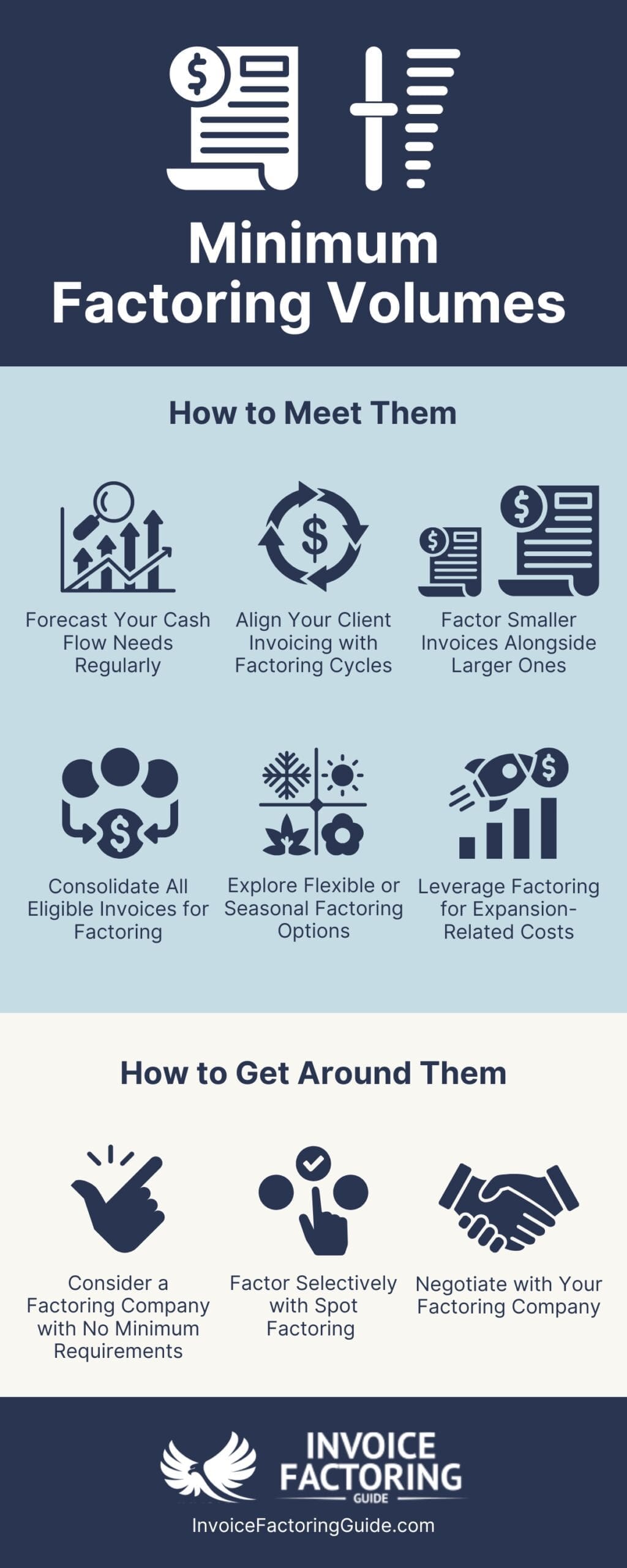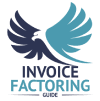
Have you ever wondered why some factoring companies insist on a minimum amount each month? While it might seem like just another clause in the contract, these volume requirements hold surprising benefits for both you and the factoring company. Below, we’ll explore why minimum factoring volumes exist and cover strategies you can use if you’re struggling to meet them.
Understanding Factoring Volume Requirements
When you factor your invoices, a factoring company buys your invoices and gives you immediate cash in return. Although the process is straightforward, factoring agreements can sometimes come with minimum volume requirements.
In simple terms, these requirements set a minimum dollar amount or number of invoices you need to factor monthly or quarterly. For instance, you might agree to factor at least $50,000 worth of invoices each month, or ten invoices minimum. Think of it as a baseline commitment to keep the partnership beneficial on both sides.
Why Factoring Companies Set Volume Requirements
Factoring companies set these criteria for a few reasons.
- Consistency in Revenue: Factoring companies thrive on predictable revenue streams, and having consistent volume requirements helps them plan their cash flow and manage resources effectively.
- Operational Efficiency: Each invoice they process involves work on their part, such as credit checks, verifications, collections, and more. With a minimum volume, they avoid handling very small, sporadic transactions, which can be less cost-effective.
- Better Pricing for Your Business: When you commit to factoring a set volume, factoring companies are often able to offer better rates, since the fixed costs of doing business are spread across more invoices. This can make it more affordable for you in the long run.
Common Factoring Volume Criteria
Every factoring company is a little different. Some common examples are covered below.
- Dollar Amount: The most common requirement is to factor a minimum dollar amount each month, like $30,000 to $50,000, depending on the industry.
- Number of Invoices: Some companies require you to submit a specific number of invoices each month. For example, you might need to factor at least ten invoices to meet the requirement.
- Annual Volume Commitment: In some cases, companies set an annual minimum rather than a monthly one, giving you flexibility across slower or busier months.
What Happens When Factoring Volume Requirements Are Not Met
If minimums are included in your factoring contract, the terms should also clarify what happens if you don’t meet them, so check your documents if you already have an agreement in place. Below, we’ll cover some ways factoring companies may address this.
Penalty Fees
The most common consequence is a penalty fee. Let’s say you agreed to factor $30,000 per month but only factored $20,000. The factoring company might charge a fee to cover the “lost volume.” This fee can be a percentage of the shortfall or a flat monthly fee.
Rate Adjustments
Factoring companies might adjust the rates you pay to factor invoices, especially if the volume falls short consistently. Higher rates compensate the company for the smaller, less predictable transaction size.
Contract Modifications or Termination
In some cases, if volume requirements aren’t met for multiple months, the company may look at modifying the agreement or even terminating it. They may shift your contract to a more flexible, and often more costly, plan if they sense your volumes won’t meet the commitment long-term.
Reduced Flexibility for the Future
Missing volume targets can impact your negotiating power when you renew or expand the contract. Factoring companies may be less willing to offer flexible terms or competitive rates if you have a track record of unmet commitments.
Strategies for Meeting Factoring Minimums

Meeting factoring minimums can feel like a challenge, especially if your business has seasonal fluctuations or fluctuating cash flow. Here are some strategies that can help ensure you’re consistently meeting those requirements without straining your operations.
Forecast Your Cash Flow Needs Regularly
Cash flow forecasting gives you a clear view of when you’ll need extra funds and helps identify months where you might be tight on invoices.
To do this, set up a simple cash flow spreadsheet or use software to track expected inflows and outflows. Identify periods with high receivables to plan for factoring those invoices in advance.
Align Your Client Invoicing with Factoring Cycles
By aligning when you invoice clients with your factoring needs, you’re more likely to have enough invoices to meet monthly minimums.
This can be achieved by invoicing larger clients earlier in the month or quarter when possible. This gives you a consistent pool of invoices to submit each month. Some companies even offer clients small discounts for early payments, which can help smooth out cash flow.
Factor Smaller Invoices Alongside Larger Ones
It’s easy to focus on large invoices to save on factoring fees, but smaller invoices add up quickly and can help meet volume requirements.
Instead of waiting until you have large invoices, consider factoring a mix. For example, if you need $30,000 and have two $10,000 invoices, add in a few smaller ones to meet the target without relying on one or two big clients.
Consolidate All Eligible Invoices for Factoring
Many companies only factor invoices from larger, reliable clients. But by factoring smaller, less frequent customers, you boost your factoring volume without requiring additional clients.
To apply this strategy, review your receivables and select all eligible invoices, not just the high-value ones. This approach ensures you’re using as many invoices as possible to reach the minimum volume.
Explore Flexible or Seasonal Factoring Options
Some factoring companies offer contracts with seasonal adjustments or “rolling minimums,” which give you flexibility during slower months.
When you sign a factoring contract, ask about options for seasonal or variable minimums. For instance, you might have a $50,000 monthly minimum but only $30,000 in slower months without penalties.
Leverage Factoring for Expansion-Related Costs
Many companies factor invoices to cover regular expenses, but it can also fund new projects or expansion. This helps keep volume up and growth on track.
When planning for growth, be it hiring, purchasing equipment, or expanding your market, consider factoring invoices to cover these new expenses. This keeps cash flow steady and helps meet minimums.
Options When You Can’t Meet Factoring Minimums
Sometimes, despite best efforts, meeting factoring minimums just isn’t feasible. If you’re facing shortfalls, there are several strategies you can explore to keep cash flow flexible without penalties or high costs.
Consider a Factoring Company with No Minimum Requirements
Some factoring companies specialize in businesses with irregular cash flows and don’t require monthly minimums. This gives you flexibility to factor invoices only when you need to.
Start by researching factoring companies offering “no minimum” or “no volume commitment” options. Many of these are geared toward smaller or seasonal businesses, so you won’t be penalized if your volume dips during slower periods.
Use Spot Factoring for Greater Flexibility
With spot factoring, you only factor individual invoices when cash flow is tight. Keep in mind that while this option is more flexible, it can have higher fees, as it doesn’t guarantee steady business for the factoring company.
Negotiate with Your Factoring Company
Many factoring companies are open to adjusting terms, especially if you’ve been a reliable client. They’d rather retain your business than lose it over volume shortfalls.
Open a discussion with your factoring company. Explain any seasonal or market-related reasons for not meeting minimums and ask if they can lower the requirement or offer a temporary adjustment. This often works best with established relationships.
Find the Right Factoring Fit for Your Business
Finding the right factoring partner means understanding your cash flow needs and any volume requirements you may face. With options ranging from flexible contracts to spot factoring, there’s a solution to fit every business model. At Invoice Factoring Guide, we can match you with a factoring company tailored to your needs. To find the right factoring fit for your business, request a complimentary rate quote.

FAQs on Minimum Factoring Volumes
Why do factoring companies have minimum volume requirements?
Factoring companies set minimums to maintain a predictable cash flow and streamline operations. Processing invoices involves fixed costs like credit checks and collections, so steady volumes make it more cost-effective. For businesses, meeting these requirements can lead to better rates, as factoring companies often offer discounts for higher or consistent volumes.
What happens if I can’t meet my factoring minimums?
If you can’t meet your minimums, factoring companies may charge a penalty, adjust your rates, or even renegotiate your contract terms. These penalties vary but can include fees based on the shortfall amount. In some cases, consistent shortfalls may lead to contract adjustments or termination. Talking to your factoring provider upfront can help explore flexible solutions.
How can I negotiate minimum volume requirements with a factoring company?
Many factoring companies are open to negotiating terms, especially if your business has seasonal fluctuations. Explain your cash flow patterns and request a lower minimum or a seasonal adjustment. If you’ve been a reliable client, the company may offer more flexibility to help you avoid penalties while keeping a steady factoring relationship.
What options do I have if my business can’t meet factoring minimums?
If meeting minimums is difficult, consider factoring companies without volume requirements, using spot factoring, or negotiating seasonal contracts. You could also explore other cash flow solutions, like lines of credit or short-term loans, to bridge the gap. Each option provides flexibility without the pressure of monthly factoring minimums.
What is spot factoring, and how does it differ from traditional factoring?
Spot factoring allows you to factor individual invoices as needed, without monthly minimums. Unlike traditional factoring, which requires a minimum commitment, spot factoring gives you flexibility for occasional cash flow boosts. It’s ideal if your business has irregular invoicing cycles, though fees may be slightly higher than traditional factoring.
Are there factoring companies that don’t require minimum volumes?
Yes, some factoring companies cater to businesses with irregular cash flow by offering contracts without minimum volume requirements. These companies allow you to factor invoices as needed without penalties for low volume. This option is especially useful for seasonal businesses or those with unpredictable revenue patterns.
Can I switch to a seasonal factoring contract if my business has seasonal fluctuations?
Many factoring companies offer seasonal contracts or rolling minimums that adjust based on your business cycle. If your volume fluctuates throughout the year, discuss this with your provider. Seasonal contracts let you lower minimums during slower months while keeping standard rates during peak periods, minimizing penalties.
How can I adjust my business model to meet factoring minimums?
Adjusting your model can help meet minimums by expanding your customer base, shortening payment terms, or offering new services to increase invoice volume. Retainer agreements and focusing on high-turnaround clients can also create a more predictable factoring flow. These small adjustments can boost revenue and keep your factoring relationship on track.
What are the benefits of factoring invoices without minimum volume commitments?
Factoring without minimums offers flexibility, especially for businesses with seasonal or fluctuating sales. You can factor only when cash flow is tight without penalties, which can lower overall costs. While rates might be higher than traditional factoring, no minimums let you access funds as needed without a long-term commitment.

About Invoice Factoring Guide
Related Articles
Get an instant funding estimate
Results are estimates based on the calculated rate and the total invoice amount provided.
Actual rates may vary.
Request a Factoring Rate Quote
PREFER TO TALK? Call us at 1-844-887-0300










